Can You Put Ceramic Coating Over Wax? No-5-Step Prep Instead
You’re staring at your car thinking, “It looks good with wax. Can I save time and put ceramic coating right over it?” I get this question a lot. I’ve been detailing and coating cars for years, and I’ll give it to you straight.
Short answer: don’t put a true ceramic coating over wax or sealant. It won’t bond right. It won’t last. You’ll end up doing the job twice.
Hang with me and I’ll show you why, how to prep the right way, and what to do if you already coated over wax. I’ll keep it simple and real.
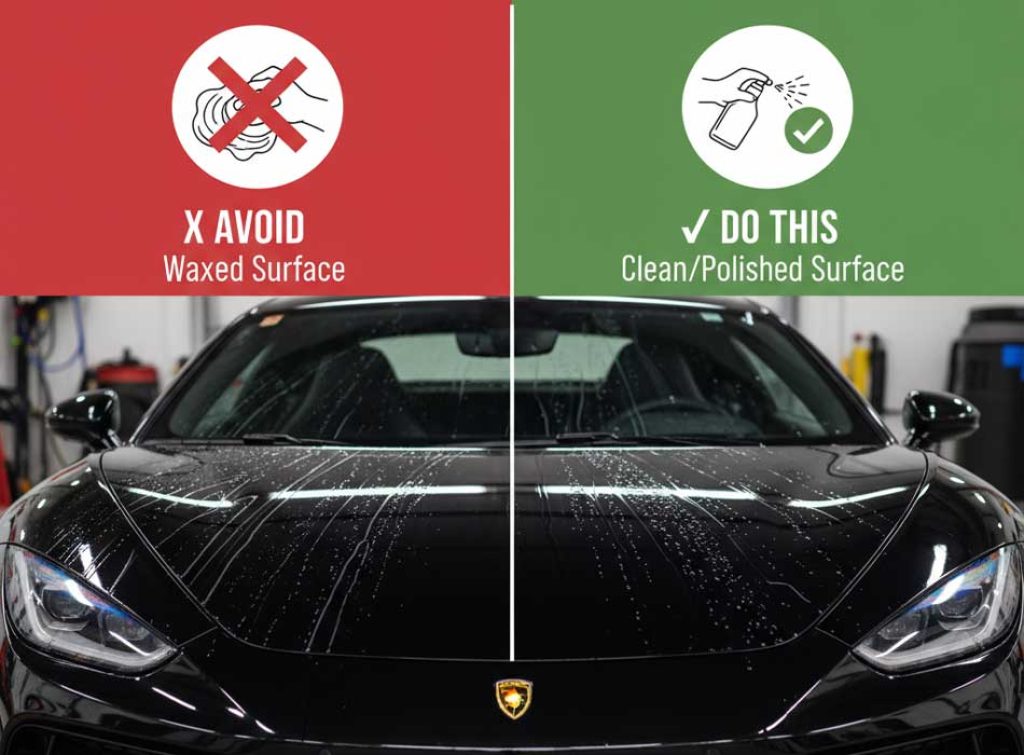
Quick story: A client once coated his car over a fresh wax because a YouTube comment said it was fine. The beads looked weird, and the coating died in three weeks. We had to polish it all off and redo it. Don’t be that guy.
Quick answer
- Can you put ceramic coating over wax?
- No, not for true ceramic coatings. Wax and sealants leave oils on the paint. Those oils block the coating from bonding.
- “Ceramic” sprays are different. Some are okay over wax, but they are toppers, not true coatings. They won’t last like one.
- What to do instead
- Strip the wax first. Wash. Decontaminate (iron remover, tar remover). Clay if needed. Polish. Panel wipe. Then apply the coating to clean, bare paint.
Question: Are you trying to coat a car the dealer just waxed? If yes, you’ll need to remove that wax first. I’ll show you how.
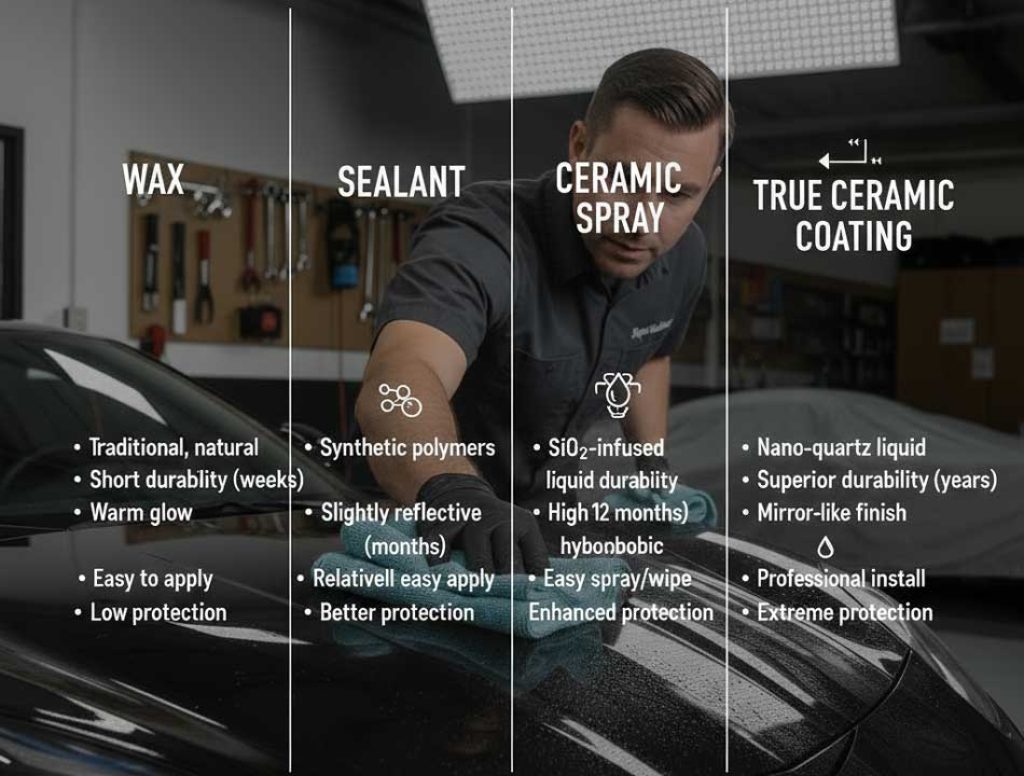
Wax vs sealant vs “ceramic spray” vs true ceramic coating
Think of these like layers with different jobs and lifespans.
| Type | What it is | How it sticks | Typical life | Apply over wax? |
|---|---|---|---|---|
| Carnauba/synthetic wax | Shiny, slick film | Sits on top of paint; oily | Weeks to a few months | N/A (it is the wax) |
| Paint sealant | Polymer layer | Sits on top; stronger than wax | 3–6 months (sometimes more) | N/A |
| “Ceramic” spray/booster | SiO2-infused spray | Sits on top; easy topper | Weeks to a few months | Often yes, but it’s still a topper |
| True ceramic coating (SiO2/SiC) | Hard, cured layer | Bonds to clean paint | 1–5 years (depends on product) | No—needs bare, clean paint |
Key idea: true coatings need a clean surface to grab onto. Wax and sealant get in the way. 15 things to avoid after coating.
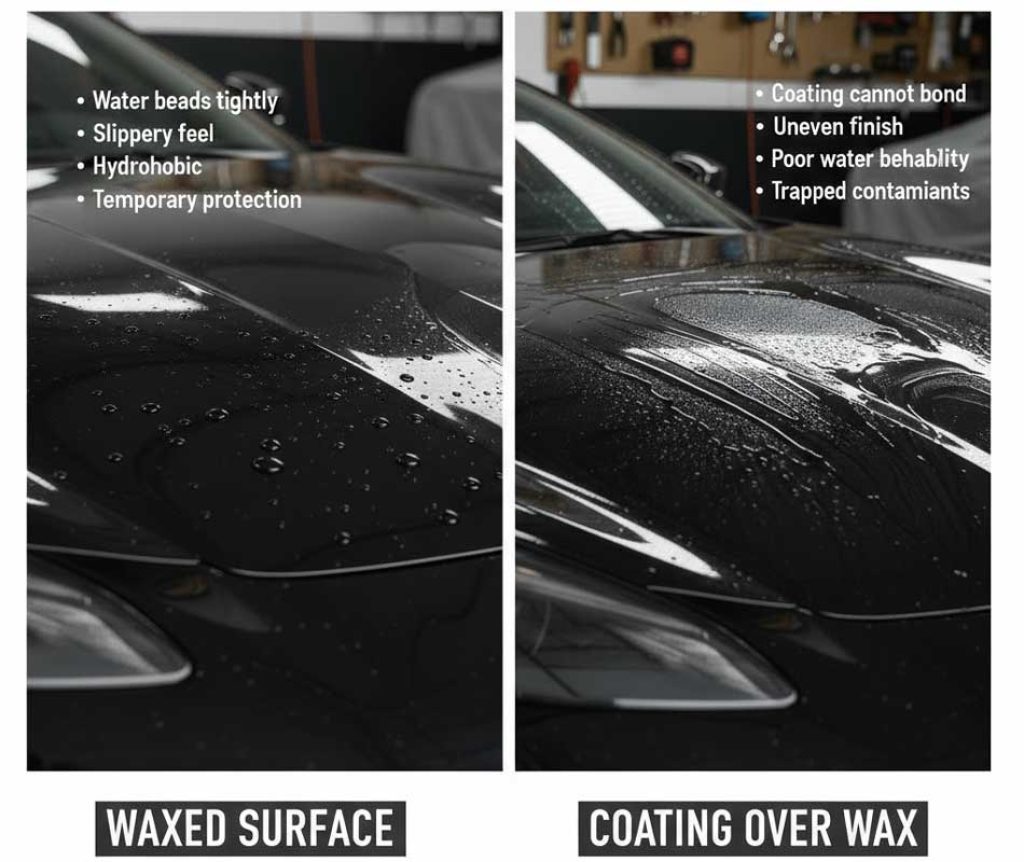
Why you should not coat over wax
Let’s keep the science simple. A ceramic coating needs to bond to the paint. It crosslinks and hardens. Wax and sealants leave oils and polymers on the surface. Those create a barrier. The coating can’t fully bond.
What goes wrong if you coat over wax:
- Patchy bonding. Some areas stick. Some don’t.
- Early failure. It can die in weeks.
- Weird water behavior. Beads look uneven. Sheeting is slow.
- Streaks and high spots that don’t level well.
- Edges start to fail during washes.
If you see hydrophobics fading fast or the surface feels grabby and inconsistent, that’s a red flag.
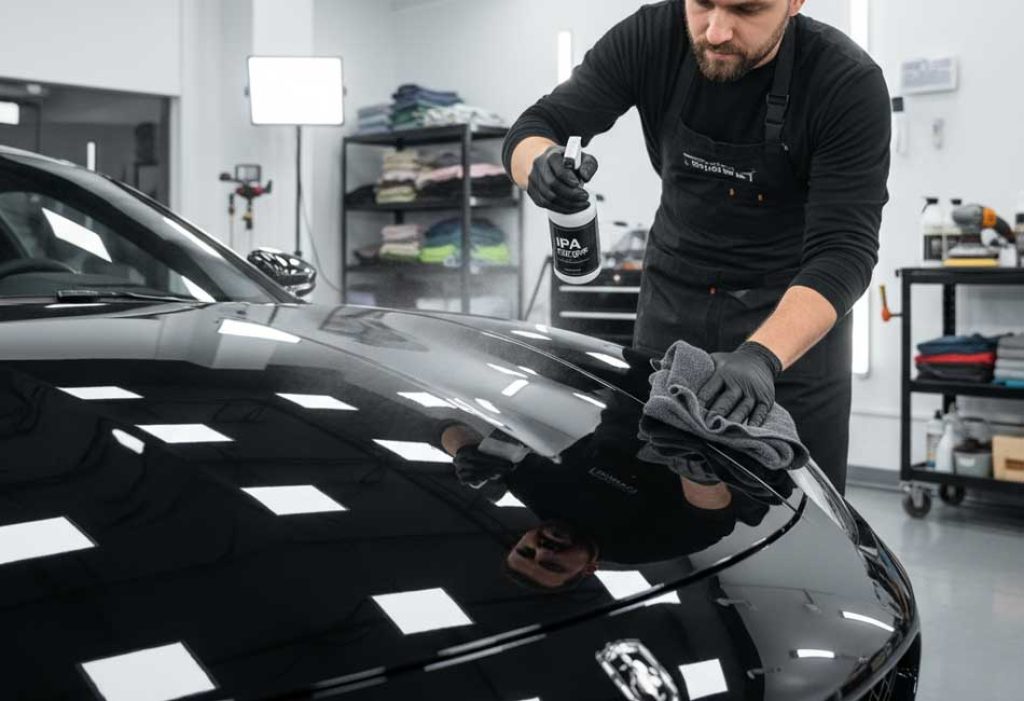
How to prep properly before ceramic coating (step-by-step)
Do this and your coating will bond strong and last longer.
- Pre-rinse and pre-wash
- Foam the car or use a pump foamer.
- Let it dwell. Rinse. This removes loose dirt so you touch the paint less.
- Contact wash
- Use a pH-neutral shampoo and a clean wash mitt.
- Two buckets. Grit guards if you have them. Rinse well.
- Chemical decon
- Iron remover: spray on paint (and wheels). You’ll often see purple bleed. Rinse well.
- Tar remover: for tar spots or road film. Let it dwell. Wipe gently. Rinse.
- Mechanical decon (clay) — only if needed
- If the paint still feels rough after decon, clay it.
- Use lots of clay lube. Light pressure. Clay will remove leftover wax too.
- Polishing
- This removes swirls, haze, and oxidation. It also clears any leftover residue.
- Do a test spot. Use a finishing polish or a two-step if defects are heavy.
- If you use a “primer polish,” make sure it’s compatible with your coating brand.
- Panel wipe
- Use a dedicated panel wipe from the coating brand.
- Or use an IPA mix (about 10–25% isopropyl alcohol in distilled water).
- Work small sections. Flip towels often. You want squeaky-clean paint.
- Final check
- Good light is key. Look for smears or oily patches.
- The paint should look clean, sharp, and grab slightly to a clean towel.
Tip: If your car was repainted recently, follow your painter’s cure time. Many paints need weeks to gas out before coating.
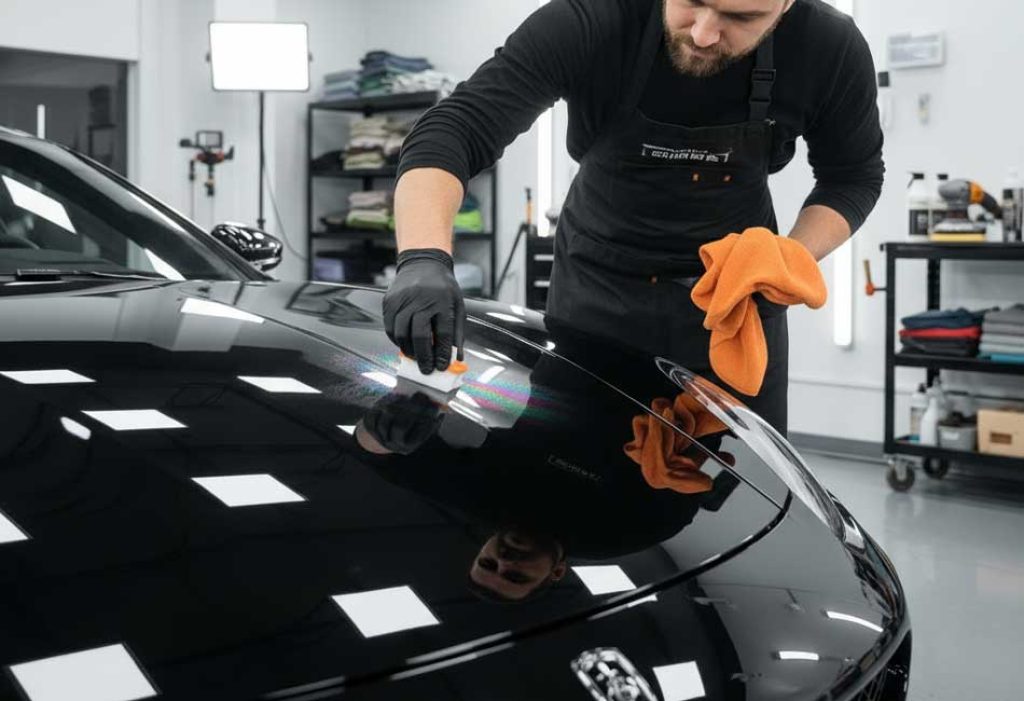
The application game plan (once paint is wax-free)
- Environment
- Shade. Cool panels. 50–80°F (10–27°C) is the sweet spot.
- Low wind. Dust-free space.
- Method
- Apply a small amount to the applicator. Work small areas.
- Watch the rainbow flash or haze per the brand.
- Level, then buff with fresh towels.
- Towels
- Use multiple clean, edgeless microfibers.
- Don’t overload one towel. Switch often.
- Curing
- Keep the car dry for 12–24 hours.
- Avoid washing for 5–7 days. Full cure can take up to 14 days.
- First topper (optional)
- After cure, use a coating-safe SiO2 booster for extra slickness and fresh beading.
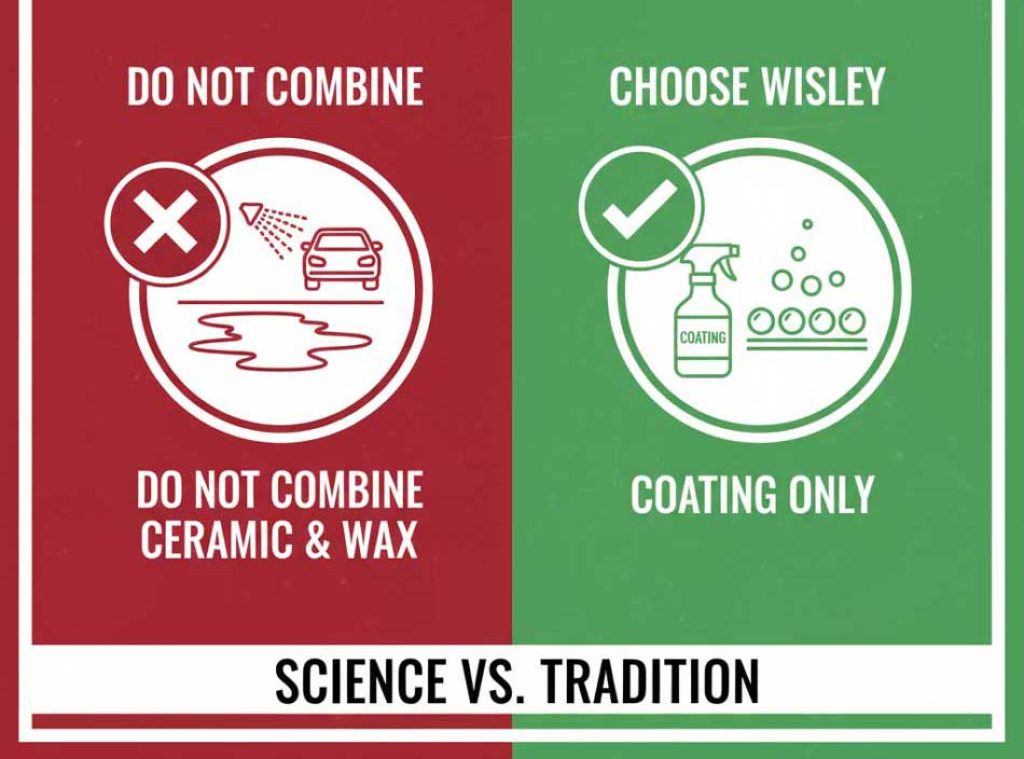
Decision guide: pick your situation
- Scenario A: Dealer just waxed your car
- Do: Wash, iron/tar decon, clay if needed, polish, panel wipe, then coat.
- Scenario B: You waxed last month
- Do: Same as above. Dish soap alone won’t strip modern waxes or sealants.
- Scenario C: You bought a used car and don’t know what’s on it
- Do: Full decon + a test spot polish. Assume it has wax or sealant.
- Scenario D: The car already has an older ceramic coating
- Do: Deep clean (alkaline pre-wash, iron remover). If it still feels dull or rough, polish and recoat.
- Scenario E: You already coated over wax (oops)
- Do: Machine polish to remove the failed coating. Re-prep. Reapply the right way.
I’ve fixed every one of these. The polish step is the reset button.
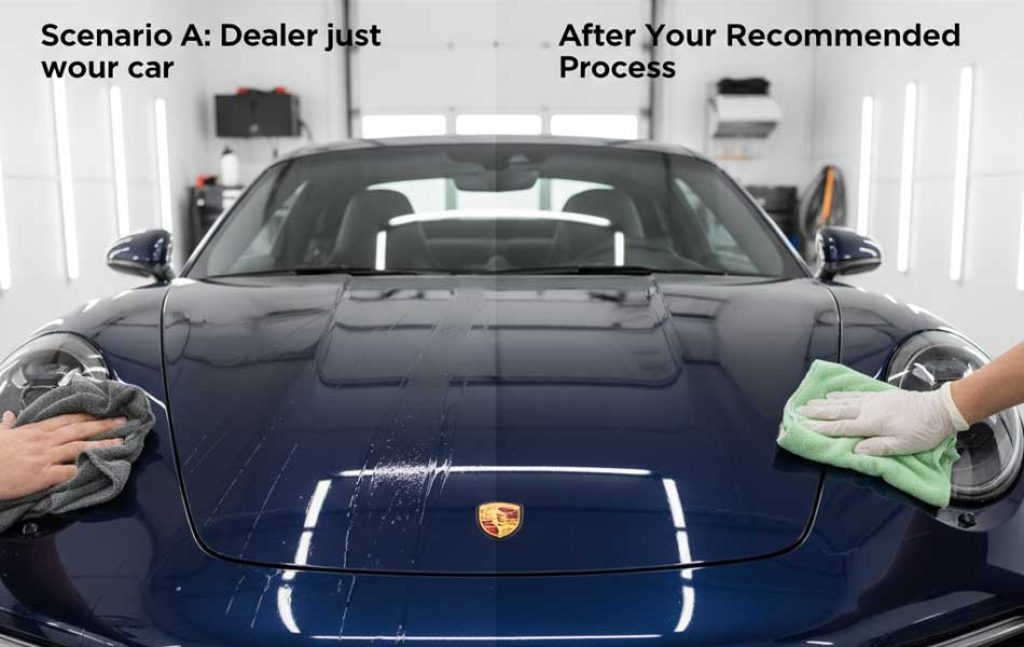
How to tell if wax or oils are still on the paint
- Water behavior test
- After panel wipe, bare paint should sheet more than it beads. Strong beading after a wipe often means protection is still there.
- Squeak test
- Wipe a clean microfiber over the paint. A clean panel has a slight grab. A slick slide can mean oils or wax are still present.
- Side-by-side test
- Wipe one half of a panel with panel wipe. Leave the other half. Compare the feel and water behavior.
- Light check
- A UV or bright inspection light can show smears or haze. That’s residue. Wipe again.
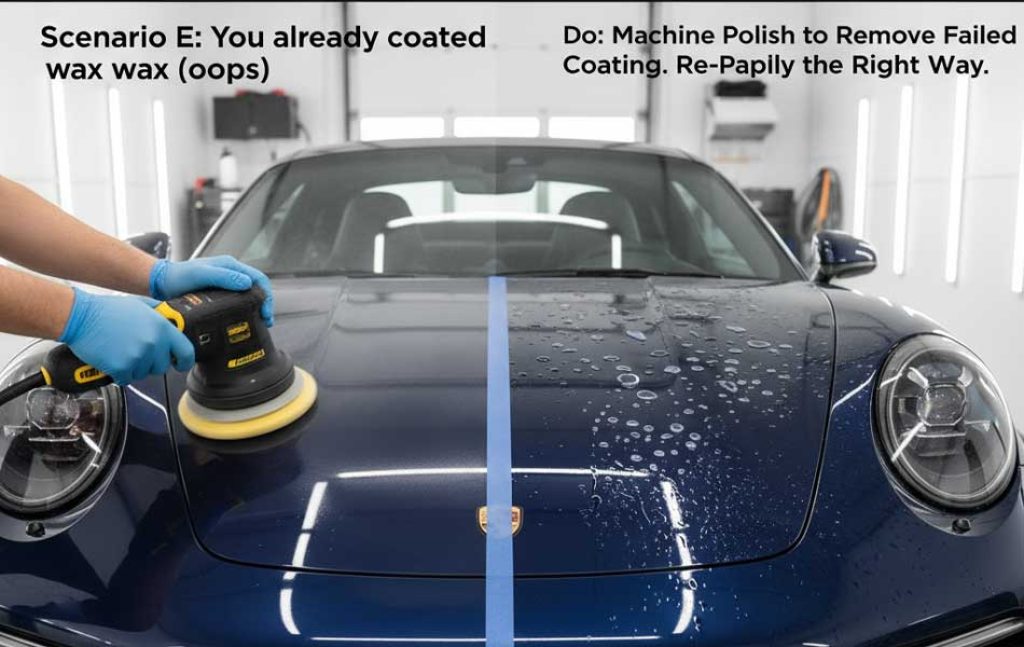
Tools and product checklist
- Pre-wash foam and a pH-neutral shampoo
- Iron remover and tar remover
- Clay bar or clay mitt + clay lube
- Dual-action polisher, pads (cutting/polishing), compound and polish
- Panel wipe or 10–25% IPA mix, many clean edgeless microfibers
- True ceramic coating kit, applicators, nitrile gloves
- Good lighting, masking tape for trim, grit guards
- Optional: IR lamp or a warm, dry garage
- Nice to have: filtered or DI water for spot-free rinsing
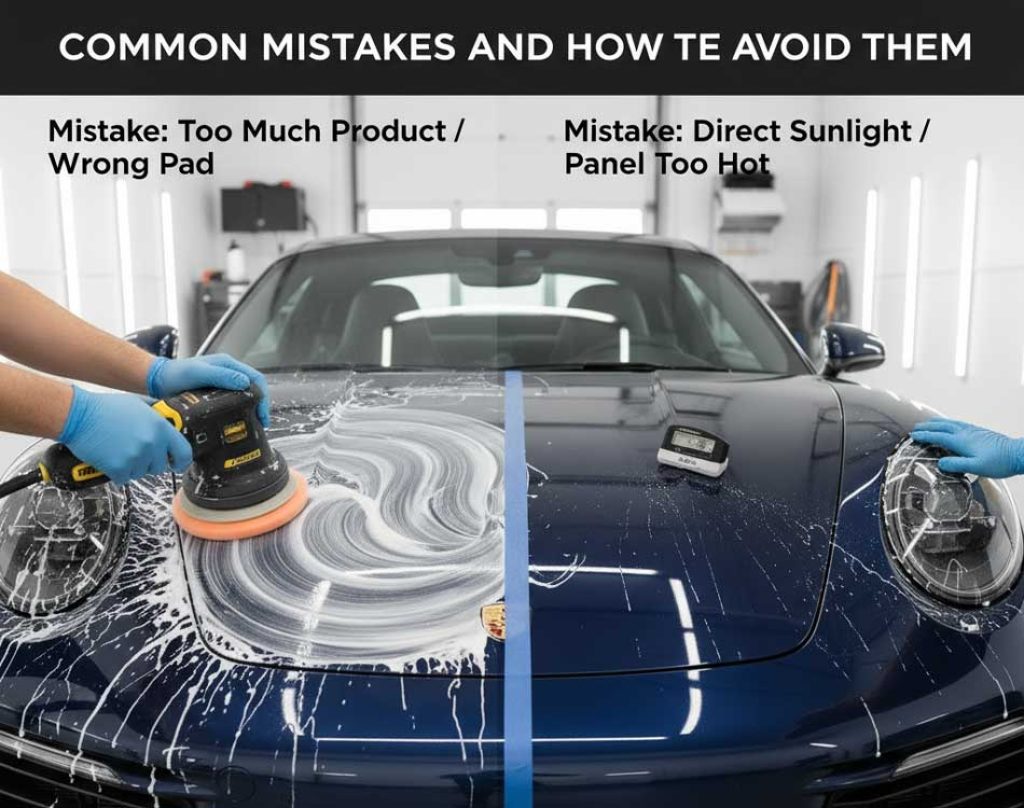
Common mistakes and how to avoid them
- “Dish soap will strip it all.”
- It knocks down oils. It won’t fully remove modern waxes and sealants. Do a full decon and polish.
- Skipping polish
- Coatings lock in whatever is under them. Fix swirls and haze first.
- Reusing the same towel for panel wipe
- You’ll just move oils around. Use many towels. Flip often.
- Coating in the sun or on hot paint
- The product flashes too fast. You’ll get streaks and high spots.
- Mixing random brands
- Primer polish from Brand A + coating from Brand B can clash. Check compatibility.
- Rushing the cure
- Rain, sprinklers, or washing too soon can mark or weaken a fresh coating.
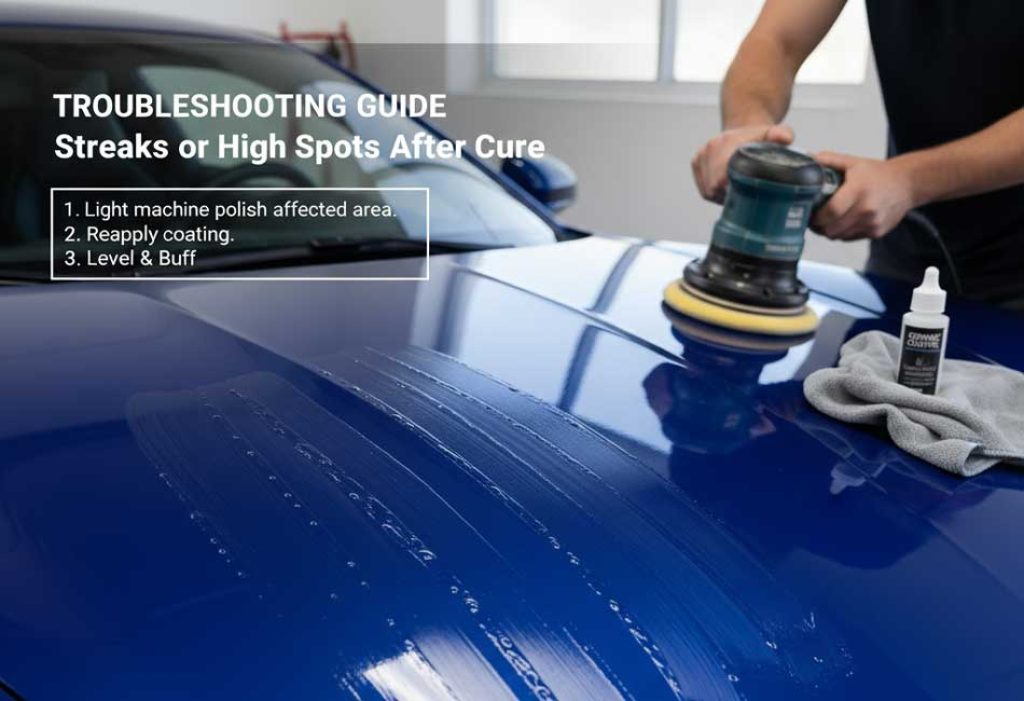
Troubleshooting and fixes
- Streaks or high spots after cure
- Light machine polish on that area. Reapply the coating there. Level and buff.
- Coating failed in a few weeks
- It likely sat on wax/oils. Polish it off. Redo the prep. Recoat.
- Patchy water behavior
- Do a deep clean: alkaline pre-wash, contact wash, iron remover.
- If no change, polish and recoat.
- Sticky or smeary wipe-off during application
- Panel is too warm or oils are present. Move to shade. Re-wipe with panel wipe. Reapply.
- Dust nibs landed during cure
- After full cure, a gentle polish can remove them. Then re-top.
Tip: If you ever feel unsure, pause and ask your coating brand or installer. It’s cheaper to ask than to fix.
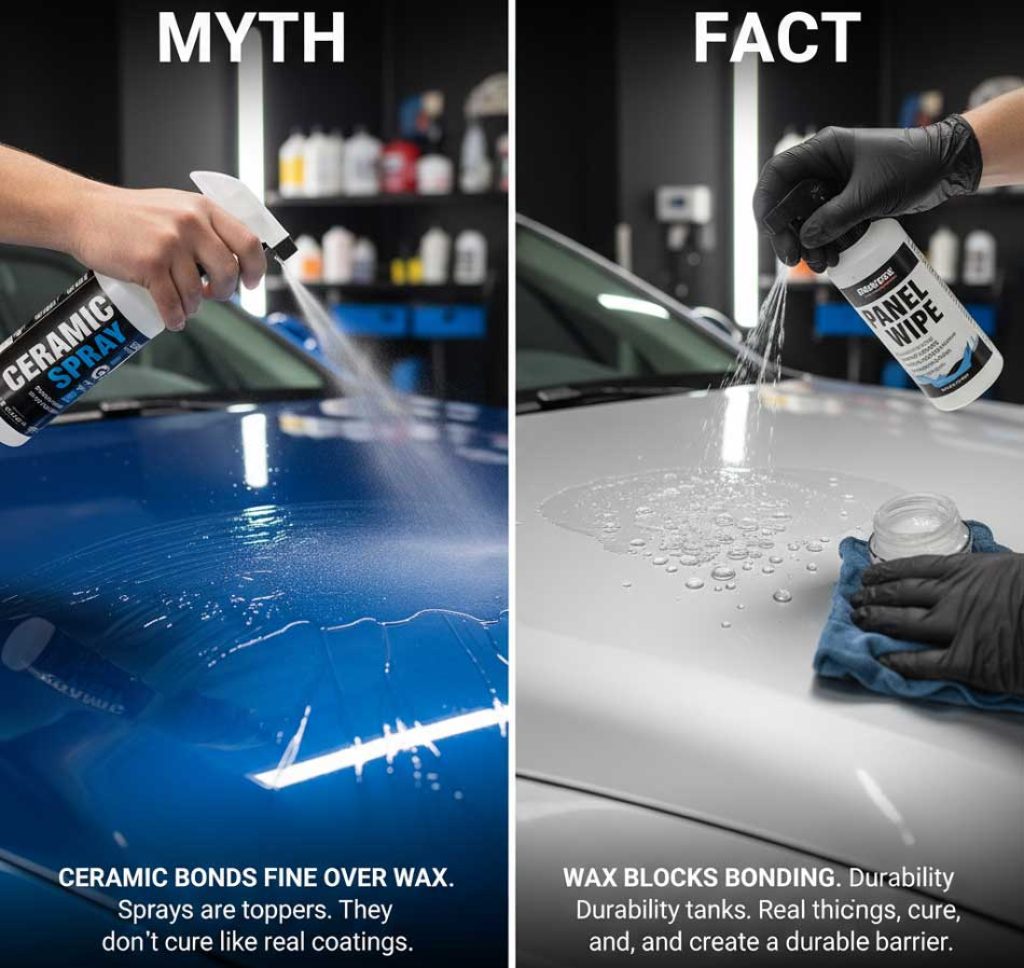
Myths vs facts
- Myth: “Ceramic bonds fine over wax.”
- Fact: Wax blocks bonding. Durability tanks.
- Myth: “Dish soap strips everything.”
- Fact: It helps. It doesn’t remove durable sealants or all oils.
- Myth: “Any ceramic spray equals a true coating.”
- Fact: Sprays are toppers. They don’t cure like real coatings.
- Myth: “Panel wipe hurts paint.”
- Fact: Used right, it safely removes oils so the coating can bond.
FAQs
- Can you put ceramic coating over wax?
- No. Remove wax and sealants first or the coating won’t bond well.
- Can I use a ceramic spray over wax?
- Many sprays work over wax, but they are toppers. They don’t last like a true coating.
- What removes wax before coating?
- Decon with iron and tar removers, clay if needed, polish, then panel wipe.
- Do I have to polish before coating?
- For best results, yes. Coatings lock in swirls and haze if you skip polish.
- How long after panel wipe can I coat?
- Right away. Work panel by panel.
- Can I wax on top of a ceramic coating?
- You can. It’s not needed. Use a coating-safe SiO2 topper instead.
- How do I know the coating bonded well?
- Even, strong beading and smooth sheeting for weeks and months. No sudden fade.
- How long should I keep it dry after coating?
- 12–24 hours dry. No washing for 5–7 days. Full cure can take up to 14 days.
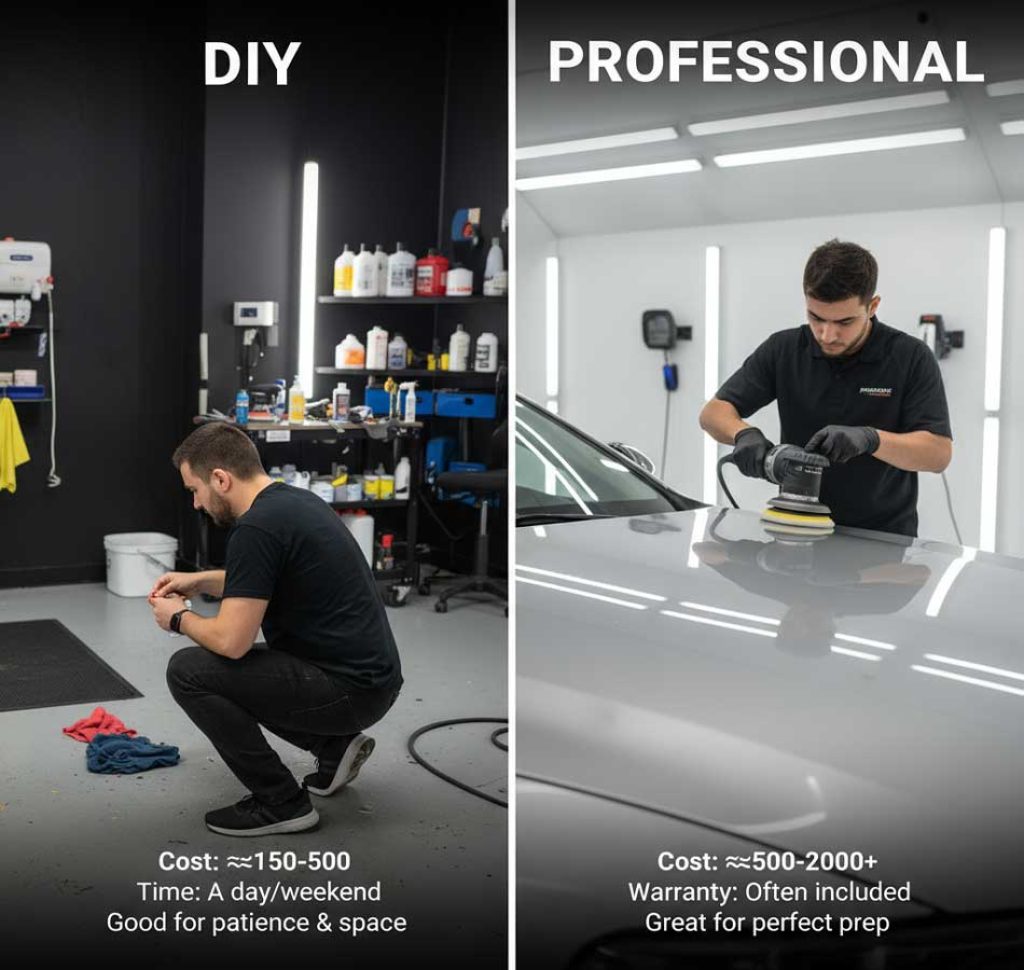
For buyers: DIY vs pro installation
- DIY
- Cost: about $150–$500 for chemicals and tools (more if you buy a polisher).
- Time: a day or a weekend.
- Good if you have space, light, and patience.
- Professional
- Cost: roughly $500–$2,000+ (depends on paint correction and coating grade).
- You get pro lighting, experience, and often a warranty.
- Great if you want perfect prep and zero stress.
Warranty note: Many pro coatings want proof of proper prep and yearly checks. Keep your receipts and follow the care guide.
Question: Do you enjoy washing your own car, or would you rather hand it to a pro and pick it up perfect?
Summary and next steps
- Don’t put a true ceramic coating over wax or sealant. It won’t bond.
- Prep is everything: wash, decon, clay if needed, polish, panel wipe.
- Apply in a cool, clean space. Use fresh towels.
- Keep it dry while it cures.
- If you made a mistake, don’t stress. Polish it off and redo it the right way.
If you want, I can send you a simple “Coating Prep Checklist” you can print and keep in the garage. Say “Send the checklist,” and tell me your car’s condition (new, used, recently waxed), and I’ll tailor it for you.

